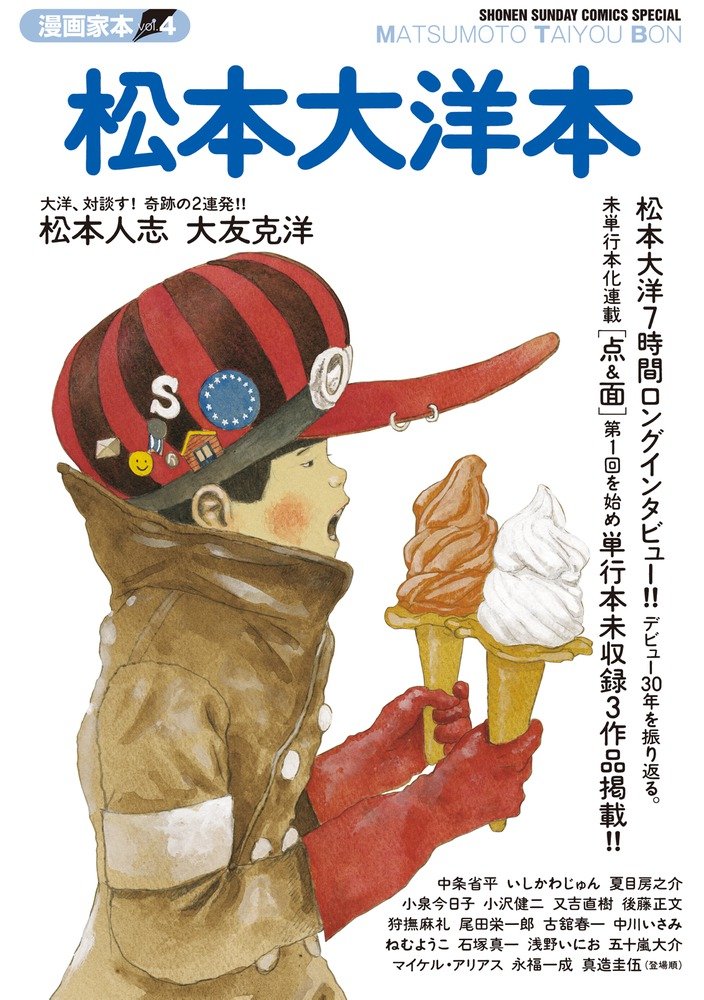- English
- 日本語
Taiyō Matsumoto, mangaka, friend
by Michael Arias
The day I first met Taiyō Matsumoto ended with both of us outdoors, naked.
But wait, let’s rewind a bit...
In 1996 my roommate Hatchan, eager to school me in manga, lent me his three-volume set of Taiyō Matsumoto’s Tekkonkinkreet, lighting a flame that would burn within me for the next ten years—years during which I was seldom without a copy of Tekkon by my side. But the first time I came face-to-face with Taiyō Matsumoto himself I had no idea that I was also beginning an even longer journey, that of my friendship with this unique artist.
After a year or so of obsessively and, I’ll admit, ineffectually pursuing my dream of a Tekkonkinkreet movie, I finally managed to connect with a few like-minded fellows and, with my 15-second Tekkon animation demo as entrée, wangle an informal meeting with Taiyō. And so, in late 1997, my comrades and I first sat down with Taiyō sensei, at a round table in a Chinatown dim sum restaurant. But after an awkward start (our giddy praise, met by Taiyō’s humble protestations), the conversation fizzled. We were all starstruck, to be sure; and Taiyō also surprised us with his unassuming earnestness—honestly, he did not seem like a guy who could have single-handedly created Zero, Hanaotoko, Tekkonkinkreet, and Ping Pong, to name just the major long-form works already under his belt.
But, helped along by copious servings of dumplings and rounds of Shaoxing wine, the conversation did eventually pick up steam. And, as is so often the case when in interesting company, we never really got round to talking about what brought us together in the first place (presumably our nascent plans for a Tekkonkinkreet movie). But it didn’t matter. All of us, Taiyō included, got some new fire in the belly from that first dinner, and none ready to call it a night. So, once done with desert, it was only natural that we change venues and continue. But I was caught completely off guard by my friend Take’s suggestion that we relocate to a nearby 24-hour health spa. And, judging from his bemused expression, Taiyō was surprised too.
Fast-forward to me and Taiyō soaking in an wooden outdoor hot tub. Maybe it’s the American in me, but even now after more than 25 years living in Japan, I still find sharing the o-furo with others a novelty (though a supremely civilized and enjoyable custom). But, as I discovered, bathing with a new acquaintance is indeed a great way to break the ice, for it is impossible to hide behind formality when one is naked in a tub of 45°C water.
Taiyō and I are both only children, and about the same age, separated by just a few months. Our parents are writers and intellectuals. Taiyō is naturally laconic and shies away from crowds; I’m introverted and brood at parties. Perhaps then because of our backgrounds, similar leanings, or, more likely, because neither of us drank much at dinner, we ended up the only survivors of that long evening, my comrades having conked out around midnight. But my audience with Taiyō seemed too precious to spend unconscious; and perhaps he too felt some kismet in our meeting. So we stayed up together until morning, discussing Tekkon, talking about our lives, soaking in the bath, and, finally, Virtua Racing each other in a dark corner of the recreation room.
A long time has passed since that first encounter. Taiyō’s hair has gone grey, as has mine; he is now married, and I have married, divorced, and then settled down again. The periods during which Taiyō and I have seen each other regularly and frequently are interleaved with long stretches of more sporadic contact. But, though I have many acquaintances and colleagues, I have very few true friends in Japan—or anywhere—with whom I have stayed close for so long. I consider Taiyō one of my dearest friends.
And yet, paradoxically, he remains the one living artist who inspires me more than any other.
It’s only natural to seek the artist in his work, and truly tempting to see Taiyō’s characters less as inventions than as projections. While working on Tekkonkinkreet, I often heard echoes of Taiyō’s voice in the words of Black and White. And many years later, translating Sunny, I saw reflections of Taiyō in his drawings of Haruo and Sei. Sometimes I sense in Taiyō a lonesome darkness—a deep, impenetrable void; is it possible that he too grapples with his own Minotaur, as I so often do?
But though I try not to conflate the artist and his art, it seems I just can’t help myself. For me, Taiyō’s oeuvre exists on an elevated plane, alongside the creations of Fellini, Tarkovsky, Kurosawa, Camus, Rushdie, Otomo, Mozart, and Lennon; and, as such, it resists all rational analysis! Anything as good as Taiyō’s best work had to have come from beyond this world, indeed from another dimension; the creator of Sunny, GoGo Monster, and Tekkonkinkreet must be more than just an ordinary human...
And yet, here he is, at my front door.
May, 2017
松本大洋、漫画家、そして友人
文:マイケル・アリアス
和訳:池田 穣
初めて松本大洋に会った日、僕らは最後に二人とも野外で裸になっていた。
ちょっと待って、少し巻き戻そう・・・。
1996年、ルームメイトだったはっちゃんは僕に漫画のことを教え込もうと熱心で、松本大洋 の『鉄コン筋クリート』3巻セットを貸してくれたのだが、お陰でそれからの10年の間(その10年間僕は『鉄コン』を手元から離す事はほぼ無かった)僕の中で燃え続ける炎が灯されたのだ。だけど、松本大洋本人と初めて直接会った時、この稀有な芸術家との友人関係という更に長い旅も始まるんだとは、僕は知る由も無かった。
一年ちょっとの期間、取り憑かれたように、そして認めよう、効果的とは言えないやり方で『鉄コン筋クリート』映画化という夢を追い続けたのちに、僕は遂に志を同じとする数人の仲間と繋がる事が出来た。それで彼らと一緒に、僕の15秒の『鉄コン』デモ・アニメを切符代わりにして、大洋さんとの非公式な面談設定に漕ぎ着けた。そして1997年の暮れ、中華街の点心屋の丸テーブルで、僕の同志達と僕は初めて大洋先生と同席したのである。だが、最初はぎこちなく(僕らは舞い上がって『鉄コン』を褒め称え、大洋さんは謙遜して否定し)、会話は続かなかった。僕らはスターを前にして明らかに平常心を失っていて、一方で大洋さんの控え目な誠実さに驚かされた―その時点で既に代表的な長編だけでも『ZERO』『花男』『鉄コン筋クリート』そして『ピンポン』をたった一人で作り上げていた人とは、正直言って思えなかった。
しかし、次から次へと運ばれて来る点心と何杯かの紹興酒の助けも有って、 僕らの会話はようやく流れに乗り始めた。そして、面白いメンツの時は大体そうだが、集まる理由だったそもそもの本題(それは僕らの『鉄コン筋クリート』映画化の初期計画だった筈だが)に話が辿り着かなかったのだ。でも、それで構わなかった。大洋さんも含めて僕らは皆、この最初のディナーの時に鳩尾の辺りに火が点いて、まだ誰もお開きにしようとしなかった。というわけでデザートを食べ終えた僕らは、自然と二軒目に流れて飲み直す事になった。なのだが、友人のタケの24時間営業の健康ランドに場所を移そうと提案には、完全に虚をつかれた。そして、大洋さんも驚いたのだろう、訳の分からないといいう表情を浮かべていた。
僕と大洋さんが木の湯船の露天風呂に浸かっているところまで早送りしよう。僕がアメリカ人だからかもしれないが、日本に25年以上住んでいる自分にとっても、誰かと一緒にお風呂に入るというのは斬新なものだ(もちろんこの上なく文化的でしかも楽しい習慣なわけだけど)。だけどその時分かった事は、新たに知り合った人と入浴するというのは、打ち解けるには凄く良いやり方なんだということだった。裸で45度の湯船に浸かりながら堅苦しいままでいるなんて無理なんだから。
大洋さんも僕もひとりっ子で、誕生日も数ヶ月違うだけでだいたい同い年だ。それぞれの親も、物書きか学者だった。大洋さんはもの静かで人混みを避ける性格だし、僕もまた内向的でパーティの誘いにはいつも躊躇してしまう。たぶん僕らがそういう素性とか傾向だからか、あるいは単に二人とも一軒目でそんなに酔っ払わなかったからか、仲間達が真夜中頃に撃沈していく中、その長い夜を生き延びているのは僕らだけになった。だけど、大洋さんに謁見しているのに意識を失うなんて僕には勿体無さ過ぎたし、たぶん大洋さんの方もこの出会いは何かの縁だと思ってくれていたんだと思う。という事で、僕らは一緒に徹夜して、『鉄コン』の議論をし、それぞれの人生の話をし、風呂に浸かり、最終的にはゲームコーナーの暗がりに有った「バーチャレーシング」で対決したのだ。
この最初の出会いから、長い年月が過ぎ去った。大洋さんは白髪になり、僕もなった。彼は結婚し、僕は結婚して離婚してそしてまた家庭を持った。大洋さんと僕は、規則正しく間を空けずに会い続けていた時期も有ったし、会うのがもっと不規則だった時期も有った。いずれにしても、僕にもたくさんの知人や同僚がいるけど、日本で、いや世界のどこでも、長い間近しくしている本当の友というのはほんの数人しかいない。そして僕は、大洋さんを最も大切な友人の一人だと思っている。
それと同時に、逆説的だが、彼は存命の芸術家としては、他の誰よりも僕をインスパイアしてくれる。
彼の作品に芸術家の姿を見出すのは自然な事だし、大洋さんの描くキャラクター達は、想像の産物というよりも何かが投影されているものと思いたくなってしまう。『鉄コン筋クリート』を作っている間、「シロ」と「クロ」の台詞に大洋さんの声の響きが聞こえる事がしばしば有った。何年も後になって『Sunny』を英訳させてもらった時にも、彼が描く「春夫」と「静」に、大洋さん自身の姿が見えた。僕は時に、孤独な暗闇のような、何物も突き通すことが出来ない深い虚空のようなものを、大洋さんの中に感じる事が有る。僕が時にそうするように、彼もまた内なる「イタチ」と格闘しているということなのだろうか?
僕はなるべく芸術家とその作品を一体化して捉えないようにしてはいるが、それでも誘惑には抗えないようだ。僕にとって大洋さんの作品は、フェリーニ、タルコフスキー、黒澤明、カミュ、サルマン・ラシュディ、大友克洋、モーツァルト、そしてジョン・レノンらが産み出したものと肩を並べる高い次元にあるし、だから彼の作品は、理屈で分析出来るようなものじゃない!大洋さんの最高傑作群くらい素晴らしい作品はこの世を超えた別次元からのものだし、『Sunny』『GOGOモンスター』そして『鉄コン筋クリート』の産みの親が単なる普通の人以上であるのは間違いないのだ・・・。
なんだけど、ほら、彼がうちに遊びに来た。
2017年5月

Manga Artist Book Vol. 4 Taiyō Matsumoto a 30-year retrospective of Taiyō's work
